110 books about Demography and 12
start with I
110 books about Demography and 12
110 books about Demography
12 start with I start with I
12 start with I start with I
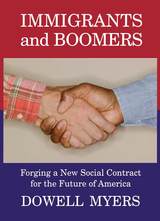
Immigrants and Boomers
Forging a New Social Contract for the Future of America
Dowell Myers
Russell Sage Foundation, 2007
"This story of hope for both immigrants and native-born Americans is a well-researched, insightful, and illuminating study that provides compelling evidence to support a policy of homegrown human investment as a new priority. A timely, valuable addition to demographic and immigration studies. Highly recommended." —Choice Virtually unnoticed in the contentious national debate over immigration is the significant demographic change about to occur as the first wave of the Baby Boom generation retires, slowly draining the workforce and straining the federal budget to the breaking point. In this forward-looking new book, noted demographer Dowell Myers proposes a new way of thinking about the influx of immigrants and the impending retirement of the Baby Boomers. Myers argues that each of these two powerful demographic shifts may hold the keys to resolving the problems presented by the other. Immigrants and Boomers looks to California as a bellwether state—where whites are no longer a majority of the population and represent just a third of residents under age twenty—to afford us a glimpse into the future impact of immigration on the rest of the nation. Myers opens with an examination of the roots of voter resistance to providing social services for immigrants. Drawing on detailed census data, Myers demonstrates that long-established immigrants have been far more successful than the public believes. Among the Latinos who make up the bulk of California's immigrant population, those who have lived in California for over a decade show high levels of social mobility and use of English, and 50 percent of Latino immigrants become homeowners after twenty years. The impressive progress made by immigrant families suggests they have the potential to pick up the slack from aging boomers over the next two decades. The mass retirement of the boomers will leave critical shortages in the educated workforce, while shrinking ranks of middle-class tax payers and driving up entitlement expenditures. In addition, as retirees sell off their housing assets, the prospect of a generational collapse in housing prices looms. Myers suggests that it is in the boomers' best interest to invest in the education and integration of immigrants and their children today in order to bolster the ranks of workers, taxpayers, and homeowners America they will depend on ten and twenty years from now. In this compelling, optimistic book, Myers calls for a new social contract between the older and younger generations, based on their mutual interests and the moral responsibility of each generation to provide for children and the elderly. Combining a rich scholarly perspective with keen insight into contemporary political dilemmas, Immigrants and Boomers creates a new framework for understanding the demographic challenges facing America and forging a national consensus to address them.
[more]

Immigration and Opportuntity
Race, Ethnicity, and Employment in the United States
Frank D. Bean
Russell Sage Foundation, 1999
The American dream of equal opportunity and social mobility still holds a powerful appeal for the many immigrants who arrive in this country each year. but if immigrant success stories symbolize the fulfillment of the American dream, the persistent inequality suffered by native-born African Americans demonstrates the dream's limits. Although the experience of blacks and immigrants in the United States are not directly comparable, their fates are connected in ways that are seldom recognized. Immigration and Opportunity brings together leading sociologists and demographers to present a systematic account of the many ways in which immigration affects the labor market experiences of native-born African Americans. With the arrival of large numbers of nonwhite immigrants in recent decades, blacks now represent less than 50 percent of the U.S. minority population. Immigration and Opportunity reveals how immigration has transformed relations between minority populations in the United States, creating new forms of labor market competition between native and immigrant minorities. Recent immigrants have concentrated in a handful of port-of-entry cities, breaking up established patterns of residential segregation,and, in some cases, contributing to the migration of native blacks out of these cities. Immigrants have secured many of the occupational niches once dominated by blacks and now pass these jobs on through ethnic hiring networks that exclude natives. At the same time, many native-born blacks find jobs in the public sector, which is closed to those immigrants who lack U.S. citizenship. While recent immigrants have unquestionably brought economic and cultural benefits to U.S. society, this volume makes it clear that the costs of increased immigration falls particularly heavily upon those native-born groups who are already disadvantaged. Even as large-scale immigration transforms the racial and ethnic make-up of U.S. society—forcing us to think about race and ethnicity in new ways—it demands that we pay renewed attention to the entrenched problems of racial disadvantage that still beset native-born African Americans.
[more]
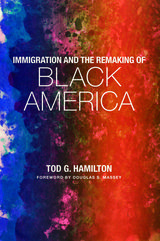
Immigration and the Remaking of Black America
Tod G. Hamilton
Russell Sage Foundation, 2019
Winner of the 2020 Otis Dudley Duncan Award for Outstanding Scholarship in Social Demography
Honorable Mention for the 2020 Thomas and Znaniecki Award from the International Migration Section of the American Sociological Association
Over the last four decades, immigration from the Caribbean and sub-Saharan Africa to the U. S. has increased rapidly. In several states, African immigrants are now major drivers of growth in the black population. While social scientists and commentators have noted that these black immigrants’ social and economic outcomes often differ from those of their native-born counterparts, few studies have carefully analyzed the mechanisms that produce these disparities. In Immigration and the Remaking of Black America, sociologist and demographer Tod Hamilton shows how immigration is reshaping black America. He weaves together interdisciplinary scholarship with new data to enhance our understanding of the causes of socioeconomic stratification among both the native-born and newcomers.
Hamilton demonstrates that immigration from the Caribbean and sub-Saharan Africa is driven by selective migration, meaning that newcomers from these countries tend to have higher educational attainment than those who stay behind. As a result, they arrive in the U.S. with some advantages over native-born blacks, and, in some cases, over whites. He also shows the importance of historical context: prior to the Civil Rights Movement, black immigrants’ socioeconomic outcomes resembled native-born blacks’ much more closely, regardless of their educational attainment in their country of origin. Today, however, certain groups of black immigrants have better outcomes than native-born black Americans—such as lower unemployment rates and higher rates of homeownership—in part because they immigrated at a time of expanding opportunities for minorities and women in general. Hamilton further finds that rates of marriage and labor force participation among native-born blacks that move away from their birth states resemble those of many black immigrants, suggesting that some disparities within the black population stem from processes associated with migration, rather than from nativity alone.
Hamilton argues that failing to account for this diversity among the black population can lead to incorrect estimates of the social progress made by black Americans and the persistence of racism and discrimination. He calls for future research on racial inequality to disaggregate different black populations. By richly detailing the changing nature of black America, Immigration and the Remaking of Black America helps scholars and policymakers to better understand the complexity of racial disparities in the twenty-first century.
Honorable Mention for the 2020 Thomas and Znaniecki Award from the International Migration Section of the American Sociological Association
Over the last four decades, immigration from the Caribbean and sub-Saharan Africa to the U. S. has increased rapidly. In several states, African immigrants are now major drivers of growth in the black population. While social scientists and commentators have noted that these black immigrants’ social and economic outcomes often differ from those of their native-born counterparts, few studies have carefully analyzed the mechanisms that produce these disparities. In Immigration and the Remaking of Black America, sociologist and demographer Tod Hamilton shows how immigration is reshaping black America. He weaves together interdisciplinary scholarship with new data to enhance our understanding of the causes of socioeconomic stratification among both the native-born and newcomers.
Hamilton demonstrates that immigration from the Caribbean and sub-Saharan Africa is driven by selective migration, meaning that newcomers from these countries tend to have higher educational attainment than those who stay behind. As a result, they arrive in the U.S. with some advantages over native-born blacks, and, in some cases, over whites. He also shows the importance of historical context: prior to the Civil Rights Movement, black immigrants’ socioeconomic outcomes resembled native-born blacks’ much more closely, regardless of their educational attainment in their country of origin. Today, however, certain groups of black immigrants have better outcomes than native-born black Americans—such as lower unemployment rates and higher rates of homeownership—in part because they immigrated at a time of expanding opportunities for minorities and women in general. Hamilton further finds that rates of marriage and labor force participation among native-born blacks that move away from their birth states resemble those of many black immigrants, suggesting that some disparities within the black population stem from processes associated with migration, rather than from nativity alone.
Hamilton argues that failing to account for this diversity among the black population can lead to incorrect estimates of the social progress made by black Americans and the persistence of racism and discrimination. He calls for future research on racial inequality to disaggregate different black populations. By richly detailing the changing nature of black America, Immigration and the Remaking of Black America helps scholars and policymakers to better understand the complexity of racial disparities in the twenty-first century.
[more]

Increase And Multiply
Governing Cultural Reproduction In Early Modern England
David Glimp
University of Minnesota Press, 2003
A wide-ranging study of the ideology of population control in early modern England.
Across the sixteenth and seventeenth centuries, a growing notion of the value of a large populace created a sense of urgency about reproduction; accordingly, a wide array of English writers of the time voiced the need not merely to add more people but also to ensure that England had an abundance of the right kinds of people. This need, in turn, called for a variety of institutions to train-and thus make, through a kind of nonbiological procreation-pious, enterprising, and dutiful subjects. In Increase and Multiply, David Glimp examines previously unexplored links between this emergent demographic mentality and Renaissance literature.
Glimp's analysis centers on humanist pedagogy as a mechanism for creating people capable of governing both themselves and others. Acknowledging the ways in which authors such as Sidney, Shakespeare, and Milton advance their own work by appealing to this vision, Glimp argues that their texts allow us to read the scope and limits of this generative ideal, its capacity to reinforce order and to become excessive and destabilizing. His work provides unprecedented insight into the role of fantasies of nonbiological reproduction in early modern political theory, government practice, and literary production.
David Glimp is assistant professor of English at the University of Miami in Coral Gables, Florida.
[more]
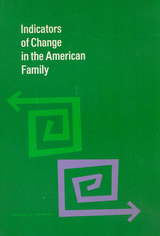
Indicators of Change in the American Family
Abbott Lamoyne Ferriss
Russell Sage Foundation, 1970
Provides a selection of existing and new measures of family change. The statistical time series are presented and organized around the topics of marriage, marital status, households, fertility, divorce, dependency, work and income, and poverty. The series selected for inclusion were chosen because of an apparent or assumed significant change which they displayed. They are illustrated by graphs and accompanied by a brief commentary. The statistical series are numbered in an appendix, and sources of the data are cited at the foot of the page of commentary.
[more]
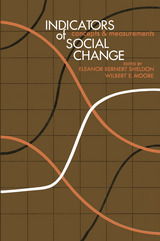
Indicators of Social Change
Concepts and Measurements
Eleanor Bernert Sheldon
Russell Sage Foundation, 1968
Includes many original contributions by an assembly of distinguished social scientists. They set forth the main features of a changing American society: how its organization for accomplishing major social change has evolved, and how its benefits and deficits are distributed among the various parts of the population. Theoretical developments in the social sciences and the vast impact of current events have contributed to a resurgence of interest in social change; in its causes, measurement, and possible prediction. These essays analyze what we know, and examine what we need to know in the study, prediction, and possible control of social change.
[more]
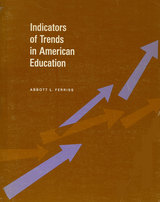
Indicators of Trends in American Education
Abbott Lamoyne Ferriss
Russell Sage Foundation, 1969
Assembles, collates, and analyzes data bearing on trends in American education. The author presents the basic data on school enrollment, retention, and attainment, indicating changes in the educational characteristics of the population and comparable time-series statistics on teachers and school finances reflecting change within the school system itself. Dr. Ferriss then relates these data to a statement of educational goals set some ten years ago, utilizing the data to provide an assessment of progress toward those goals.
[more]
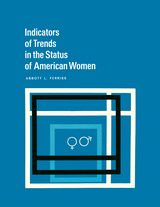
Indicators of Trends in the Status of American Women
Abbott Lamoyne Ferriss
Russell Sage Foundation, 1971
Assembles, collates, and analyzes data bearing on trends in American education. The author presents the basic data on school enrollment, retention, and attainment, indicating changes in the educational characteristics of the population and comparable time-series statistics on teachers and school finances reflecting change within the school system itself. Dr. Ferriss then relates these data to a statement of educational goals set some ten years ago, utilizing the data to provide an assessment of progress toward those goals.
[more]
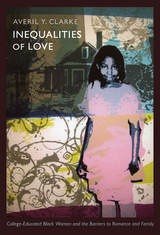
Inequalities of Love
College-Educated Black Women and the Barriers to Romance and Family
Averil Y. Clarke
Duke University Press, 2011
Inequalities of Love uses the personal narratives of college-educated black women to describe the difficulties they face when trying to date, marry, and have children. While conventional wisdom suggests that all women, regardless of race, must sacrifice romance and family for advanced educations and professional careers, Averil Y. Clarke’s research reveals that educated black women’s disadvantages in romance and starting a family are consequences of a system of racial inequality and discrimination. The author analyzes the accounts of black women who repeatedly return to incompatible partners as they lose hope of finding “Mr. Right” and reject unwed parenting because it seems to affirm a negative stereotype of black women’s sexuality that is inconsistent with their personal and professional identities. She uses national survey data to compare college-educated black women’s experiences of romance, reproduction, and family to those of less-educated black women and those of white and Hispanic women with degrees. She reports that degreed black women’s lives include less marriage and sex, and more unwanted pregnancy, abortion, and unwed childbearing than college-educated white and Hispanic women. Black women’s romantic limitations matter because they constitute deprivation and constraint in romance and because they illuminate important links between race, class, and gender inequality in the United States. Clarke’s discussion of the inequities that black women experience in romance highlights the connections between individuals’ sexual and reproductive decisions, their performance of professional or elite class identities, and the avoidance of racial stigma.
[more]
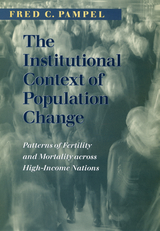
The Institutional Context of Population Change
Patterns of Fertility and Mortality across High-Income Nations
Fred C. Pampel
University of Chicago Press, 2001
Despite having similar economies and political systems, high-income nations show persistent diversity. In this pioneering work, Fred C. Pampel looks at fertility, suicide, and homicide rates in eighteen high-income nations to show how they are affected by institutional structures. European nations, for example, offer universal public benefits for men and women who are unable to work and have policies to ease the burdens of working mothers. The United States, in contrast, does not. This study demonstrates how public policy differences such as these affect childbearing among working women, moderate pressures for suicide and homicide among the young and old, and shape sex difference in suicide and homicide.
The Institutional Context of Population Change cuts across numerous political and sociological topics, including political sociology, stratification, sex and gender, and aging. It persuasively shows the importance of public policies for understanding the demographic consequences of population change and the importance of demographic change for understanding the consequences of public policies.
The Institutional Context of Population Change cuts across numerous political and sociological topics, including political sociology, stratification, sex and gender, and aging. It persuasively shows the importance of public policies for understanding the demographic consequences of population change and the importance of demographic change for understanding the consequences of public policies.
[more]

Introduction to Demography
Revised edition
Mortimer Spiegelman
Harvard University Press
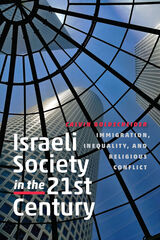
Israeli Society in the Twenty-First Century
Immigration, Inequality, and Religious Conflict
Calvin Goldscheider
Brandeis University Press, 2015
This volume illuminates changes in Israeli society over the past generation. Goldscheider identifies three key social changes that have led to the transformation of Israeli society in the twenty-first century: the massive immigration of Jews from the former Soviet Union, the economic shift to a high-tech economy, and the growth of socioeconomic inequalities inside Israel. To deepen his analysis of these developments, Goldscheider focuses on ethnicity, religion, and gender, including the growth of ethnic pluralism in Israel, the strengthening of the Ultra-Orthodox community, the changing nature of religious Zionism and secularism, shifts in family patterns, and new issues and challenges between Palestinians and Arab Israelis given the stalemate in the peace process and the expansions of Jewish settlements. Combining demography and social structural analysis, the author draws on the most recent data available from the Israeli Central Bureau of Statistics and other sources to offer scholars and students an innovative guide to thinking about the Israel of the future. This book will be of interest to scholars and students of contemporary Israel, the Middle East, sociology, demography and economic development, as well as policy specialists in these fields. It will serve as a textbook for courses in Israeli history and in the modern Middle East.
[more]
READERS
Browse our collection.
PUBLISHERS
See BiblioVault's publisher services.
STUDENT SERVICES
Files for college accessibility offices.
UChicago Accessibility Resources
home | accessibility | search | about | contact us
BiblioVault ® 2001 - 2024
The University of Chicago Press









